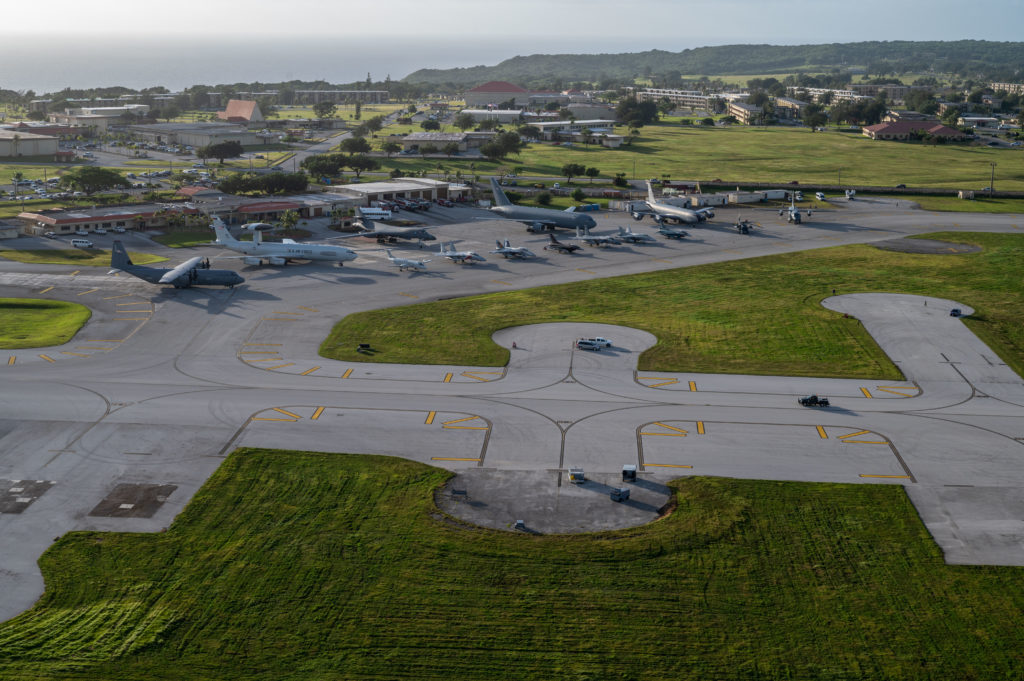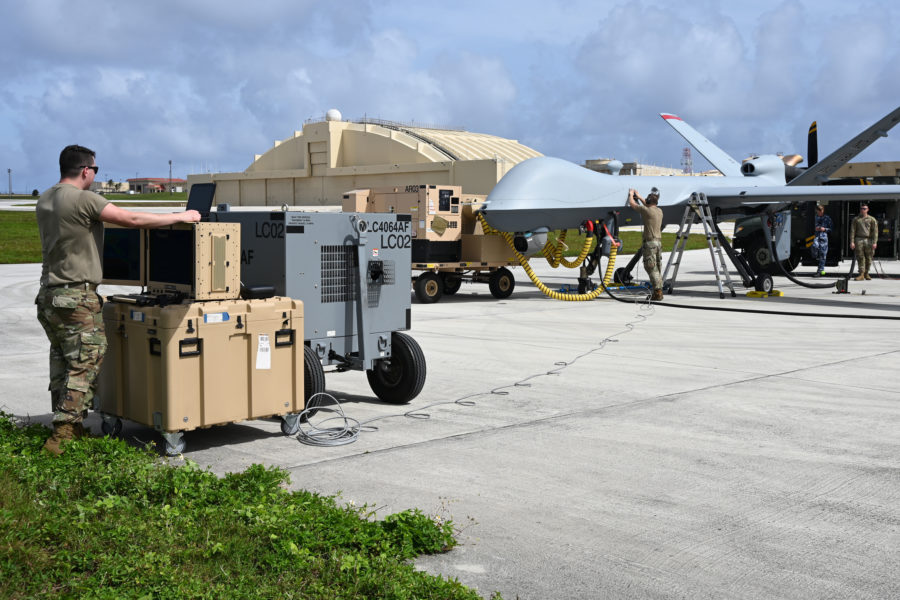Last month, the Air Force’s evolving Agile Combat Employment (ACE) doctrine received arguably its most rigorous test yet in the annual Cope North exercise, as Air Force, Navy, and Marine Corps fighter and bomber aircraft, backed by aerial refuelers and airborne early warning and control aircraft and supported by Japanese fighters and French and Australian transports, fanned out across 1,200 miles of ocean and far-flung Pacific islands. They operated from a hub-and-spoke system of 10 air bases spread from Iwo Jima in the north, through Saipan, Rota, and Guam, and down to Micronesia and the Palau archipelago to the distant south.
“In terms of the scope and complexity of the basing challenge, the 2023 iteration of Cope North was nothing like its predecessors. What I saw during the exercise was night and day from some of the concerns I’ve heard expressed about ACE,” Brig. Gen. Paul R. Birch, commander of the 36th Wing out of Andersen Air Force Base, Guam, said while moderating a panel on “Defining Optimized Resilient Basing” at the AFA Warfare Symposium on March 7. “We can now debunk some of those concerns, because [after Cope North] we now know exactly what the key elements of ACE are, and we know exactly what a resilient base looks like.”
The imperative driving ACE is the need to greatly disperse U.S. and allied air bases across the Indo-Pacific region in a way that complicates targeting for China and its massive arsenal of ballistic missiles. The Cope North exercise revealed both the promise of that doctrine, and the challenge of building resiliency with such a widely dispersed basing footprint.

For one, the exercise revealed that complicating an adversary’s targeting challenge is necessary but not sufficient, Birch said.
“We also have to generate airpower from the bases that is lethal and useful in helping us compete and win,” he noted.
The task of building a more dispersed yet resilient basing footprint is forcing the Air Force to relearn some lessons that atrophied in the permissive post-Cold War era of uncontested major operating bases.
For instance, the service needs to refine its prepositioning of materiel—the weapons, ammunition, fuel, and maintenance equipment needed to generate air sorties from austere bases. Base protection is also increasingly important, running the gamut from passive measures such as hardened aircraft shelters, camouflage, concealment, and deception, to active air defenses such as PATRIOT systems or other surface-to-air missiles. Rapid runway repair capabilities will also be needed to reconstitute damaged airfields.
“To be successful we need to have the right amount of prepositioned materiel, at the right scalability, so that it is available or arrives in time to meet the need, but not overdoing it to the point that it rots in the tough climate and environment that we face in the Indo-Pacific,” said Birch. “Base protection is also imperative, and it can take many forms. At the same time, being a target isn’t our main focus. Rather, the focus is getting our airpower off the ground in a way that is lethal.”
The model of dispersed basing dictated by ACE also puts added strain on command-and-control, logistics, and manpower. In each arena, the challenges of working in an austere environment will be greatly magnified in a time of conflict.
“When you think about having to operate in an austere environment where you don’t have a lot of the infrastructure and support associated with a main operating base, and then consider how that looks in a ‘contested’ or even ‘denied’ scenario, it can become really challenging,” said Ryan Bunge, the general manager for resilient networking and autonomous solutions at Collins Aerospace. “If you think of what the first nights of a conflict might look like, an expeditionary commander’s ability to pop up on the command-and-control network and get an intelligence update or a new air tasking order might be impaired. To help the Air Force meet that challenge, we’re looking at providing more resilient connectivity.”
Such resiliency could be offered by commercial and military satellite communications systems, or even high-frequency radio enabled by digital mesh networking.
Defense industry representatives also believe artificial intelligence and machine learning systems can help the Air Force can meet the logistical challenges raised by more far-flung operations.
“Optimization is key to creating more resilient supply chains, so think of a neural network that can predict before a human when there will be a supply disruption due to weather, a supply shortage, or an adversarial threat,” said Thom Kenney, technical director at Google’s Office of the CTO. “Having automated systems that can accurately predict in advance a break in the supply chain would be a huge advantage.”
With ACE and its focus on dispersed operations demanding more “Multi-Capable Airmen” who can operate out of their normal career fields, industry representatives also said AI and autonomous systems can help the service better deal with manpower strains.
“In order for these expeditionary bases to be protected, we’re already offering autonomous force protection solutions,” said Brad Reeves, director for C4I solutions for Elbit Systems of America. “Think of a single Airman operating a fully autonomous team of unmanned platforms that are able to conduct observation and sensing around not just an expeditionary base, but also beyond the base to the entire island or even beyond that to an entire littoral maritime region. Such multi-domain, air, land, and sea awareness would give a base commander the knowledge necessary in order for him to launch and recover aircraft in a safe manner.”

